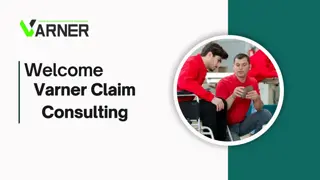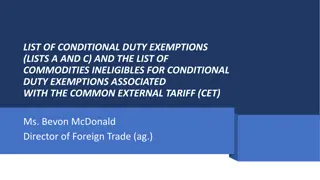Ensuring Employee Fitness for Duty in the Workplace
Learn how to identify unfit employees, understand fitness for duty guidelines, use checklists, and handle unfit situations effectively. Supervisors play a crucial role in monitoring performance, assessing fitness, and following guidelines. Proper documentation and the Reasonable Prudent Person Test are essential in assessing employees' physical, emotional, and mental conditions. Address reasons for unfitness, such as stress, mental illness, drugs, and alcohol, to maintain a safe workplace environment.
Download Presentation

Please find below an Image/Link to download the presentation.
The content on the website is provided AS IS for your information and personal use only. It may not be sold, licensed, or shared on other websites without obtaining consent from the author.If you encounter any issues during the download, it is possible that the publisher has removed the file from their server.
You are allowed to download the files provided on this website for personal or commercial use, subject to the condition that they are used lawfully. All files are the property of their respective owners.
The content on the website is provided AS IS for your information and personal use only. It may not be sold, licensed, or shared on other websites without obtaining consent from the author.
E N D
Presentation Transcript
OBJECTIVES Identify unfit employees Understand Fitness for Duty Guidelines Know how to use checklists Understand what to do Know roles of SEAP, union, law enforcement, medical services, and management. 2
FITNESS FOR DUTY THE PHYSICAL/EMOTIONAL AND MENTAL CONDITION OF AN EMPLOYEE IS SUCH THAT HE/SHE IS CAPABLE OF PERFORMING HIS/HER DUTIES IN A SAFE AND COMPETENT MANNER. 3
For all employees : For all employees : Report to work fit for duty Report to work fit for duty Remain fit while on duty Remain fit while on duty 4
Supervisors should Supervisors should ... ... Monitor performance & behavior Monitor performance & behavior Assess fitness Assess fitness Follow guidelines if employee is unfit Follow guidelines if employee is unfit 5
UNFIT FOR DUTY An employee who cannot perform An employee who cannot perform his/her duties in a proper, safe and his/her duties in a proper, safe and competent manner competent manner - - Regardless of reason Regardless of reason 6
REASONS WHY Stress Emotional Undiagnosed physical problem Mental Illness Drugs Alcohol 7
DOCUMENTATION Specific verifiable behaviorial observations Objective & Non-judgmental 8
WHAT DO YOU DO ... The Reasonable Prudent Person Test Assess: - physical characteristics - intellectual ability to perform - interpersonal behavior - judgment Consider: -policies -safety/competency criteria -job duties Then . . . 9
Behaviorthreatens Healthand Safety of Workplace Contact appropriate law enforcement and other emergency services or Contact SEAP to coordinate intervention As appropriate utilize Commonwealth Workplace Violence Report 10
CLEAR AND PRESENT DANGER CLEAR AND PRESENT DANGER Criteria... Happening now/immediate future Reasonable person would view situation as real threat Person has plan and means 11
Behavior constitutes a clear medical or psychiatric emergency Options : Contact the county crisis intervention unit Contact emergency medical services Contact SEAP to coordinate intervention 12
DUTY TO WARN DUTY TO WARN Tarasoff Decision Child Protective Services Greater good outweighs confidentiality rights 13
It is determined that the behavior does not require immediate intervention by police or emergency personnel then . . . FITNESS FOR DUTY GUIDELINES 14
FITNESS FOR DUTY GUIDELINES What not to do What to look for How it works Union role What to ask What to do 15
THE PROCESS INCLUDES: Observation Interview Action Follow Through 16
OBSERVATION Breath/Smell Movements Eating/Chewing Demeanor Actions Cognitive Walking/Standing Speech Eyes Face Appearance Ambiguous Situations USECHECKLIST 17
Interview Conduct in private location Allow union representation Be respectful Have another supervisor/manager present 18
QUESTIONS TO ASK . . . Feeling ill? Under Doctor s care? Taking any medication? Forget to take meds? Non-prescription meds? Side effects? Alcohol or other drugs? How do you explain behavior ? 19
CAUTION Do not attempt to diagnose! 20
Now what? Action Now what? Action If fit - return to duty Counsel for behavior, if appropriate 21
Now what? Action Now what? Action The Reasonable Prudent Person Test If unfit - Contact Administrator What to say to employee Remove employee safely Contact OA-SEAP Prepare for Return 22
Possible Actions Possible Actions Discipline Mandatory SEAP referral COCE Termination 23
AMBIGUOUS SITUATIONS BORDERLINE OR UNCERTAIN sleeping on duty slurring words blurry/red eyes alcohol on breath 24
REMEMBER DO Respond Seek second party Respect - be professional Document Be objective Limit to performance - work related Escort employee Contact authorities & SEAP DON T Ignore Make judgments in isolation Belittle or moralize Exaggerate or minimize Interpret or diagnose Delve into personal issues Allow employee to drive Let it drop 25
WHAT WOULD YOU DO IF... WHAT WOULD YOU DO IF... An employee seems distraught, agitated, and abusive, threatening to do harm to you and anyone else who gets in his way? 26
WHAT WOULD YOU DO IF... WHAT WOULD YOU DO IF... An employee comes back from lunch smelling of alcohol, overtly happy, joking, but otherwise acting normal ? 27
WHAT WOULD YOU DO IF... WHAT WOULD YOU DO IF... An employee did not look well when she reported for work; she said she probably was coming down with a cold. Later in the shift, you saw the employee sitting down, pale, and apparently in pain? 28
WHAT WOULD YOU DO IF... WHAT WOULD YOU DO IF... An employee, who happens to be covered by the CDL regulations, has become increasingly withdrawn, with frequent mood changes, alternating periods of lethargy, and hyperactivity. Today he appears confused, with an inability to concentrate or remember basic procedures. When approached, he was belligerent? 29
WHAT WOULD YOU DO IF... An employee reports to work overtly upset, rambling on in an incoherent manner about people not pulling their weight, intentionally causing trouble, increasingly becoming hostile and over reacting to anything anyone does or says? 30
WHAT WOULD YOU DO IF... An employee s child died several months ago. The employee continues to act depressed. Today she seems more anxious than usual, with tears in her eyes. She says she has an allergy. You think you have seen her hands tremor. It seems like she is trying to avoid everyone. You are concerned because later that shift, she will have to be alone for a few hours and be responsible for safety sensitive work? 31























